WHAT'S NEW:
BACKGROUND:
Mission
Project Description
Cruise Plans:
Participants
Technology (ROV, ships, etc.)
Future Plans
Results:
1998 NeMO Cruise
Axial 1998 "Eruption"
Logbook
July 6, 1999
July 6, 1999
Contents:
- News from Thompson
- Participant Perspective
- Logbook from Teacher at Sea
- Question/Answer from shore to sea
Thompson Science Report
Science Report - Tuesday, July 6
Ships Location: 45 55.9/129 59.0
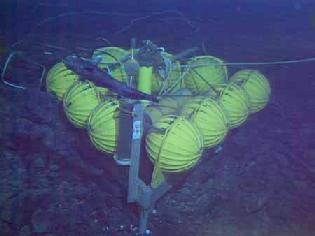
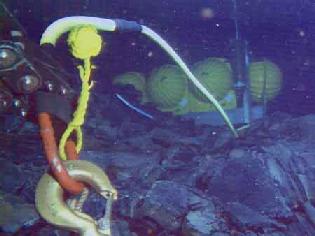 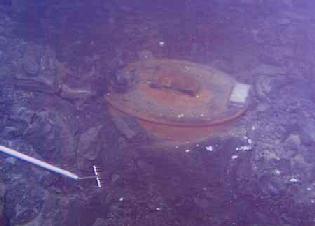 
From top to bottom: Rumbleometer stuck in lava flow; then ROPOS attaching lines for recovery attempt; Rumbleometer's anchor remains in lava flow; Instrument floating free for recovery! |
Listing of all Science News postings
Life at Sea: Participant Perspective
Christina and Cheryl Ells
R/V Thompson
Sisters at Sea
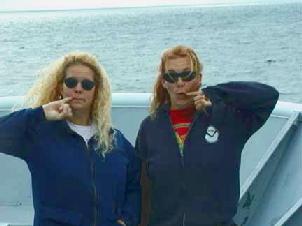 Christina and Cheryl Ells have been going to Sea (on and off) over a period
of thirteen years before the ROPOS Cruise, Cheryl convinced her Sister
to return to Sea after a Seven Year hiatus to give them the chance to
sail together.
Christina and Cheryl Ells have been going to Sea (on and off) over a period
of thirteen years before the ROPOS Cruise, Cheryl convinced her Sister
to return to Sea after a Seven Year hiatus to give them the chance to
sail together.
Christina:
Christina is a Licensed Massage Therapist with her own practice in
Seattle and thought a trip out to Sea would offer a nice little break.
Christina's position on the ship is "Galley Slave." She did bring her
massage table so as not to get out of touch!
Cheryl:
Cheryl, is an Able Bodied Seaman, who recently returned from a cruise
around the world with NOAA, to return once again to the Thompson. She is
saving money to return to school in the study of Naturopathy, Yoga and
Meditation.
Listing of all Perspectives postings
Teacher At Sea Logbook
Teachers Log #16 7/6/99
As soon as ROPOS was settled and secured to the deck last night the excitement began. For many it was a long night in the lab sample recording, analyzing, and data processing. This morning ROPOS was ready to begin its new mission, recovery of the Rumbleometer.
In October of 1997, two instrument packages called Rumbleometers were deployed to provide a continuous daily recording of the activity within the Axial Caldera and along the South Rift Zone. Each Rumbleometer was comprised of five sensing and recording instruments, each specifically designed to detect and record changes in this active region. Pressure gauges would pick up any changes in the depth of the sea floor by recording either increases or decreases in pressure. Seismic sensors were tuned for sensing the harmonic tremors that accompany volcanic eruptions. Current meters used for measuring the movement of the water around the instrument and, temperature recorders were also included. A tiltmeter would hopefully provide information about any faulting or shifting that took place. These Volcano System Monitors (VSM, official name of Rumbleometer instrument) were put to task soon after they were deployed. The January 1998 eruption took place near the Rumbleometers. This eruption, and associated seismic activity, lasted for 11 days and migrated southward.
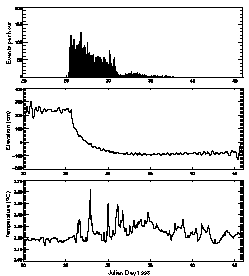 Data from 1998 recovered VSM showing the 3 meters of downdrop associated with the eruption. |
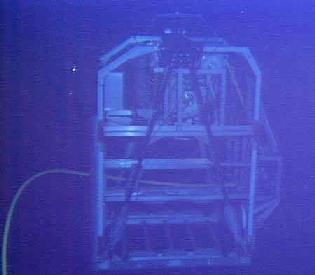 ROPOS's cage used to pull at the Rumbleometer, setting it free after 20 months on the seafloor. |
Bye for now.
Logbook of all Teacher At Sea postings
Questions & Answers
Q: Do you know if the fissure went together?
Kelly Chadwick, age 6
(Kelly's father,
Bill, is aboard the Thompson).
 A: Hi Kelly!
The fissure that opened up and erupted the lava flow last year (photo
right) has solidified lava in it now, so it cannot close back up. In fact,
this is what seafloor spreading is all about - the two tectonic plates
are being slowly pulled apart, periodically a crack opens along the plate
boundary, magma fills the crack (forming a dike), and the plates are then
a little further apart than they were to start with. Judging from what
we saw on the seafloor, the Pacific and Juan de Fuca tectonic plates spread
apart by about 1.5 meters during the 1998 eruption. On the other hand,
the fissure we saw on the seafloor does come together at either end -
that is, it is open in the middle and pinches shut at either end.
A: Hi Kelly!
The fissure that opened up and erupted the lava flow last year (photo
right) has solidified lava in it now, so it cannot close back up. In fact,
this is what seafloor spreading is all about - the two tectonic plates
are being slowly pulled apart, periodically a crack opens along the plate
boundary, magma fills the crack (forming a dike), and the plates are then
a little further apart than they were to start with. Judging from what
we saw on the seafloor, the Pacific and Juan de Fuca tectonic plates spread
apart by about 1.5 meters during the 1998 eruption. On the other hand,
the fissure we saw on the seafloor does come together at either end -
that is, it is open in the middle and pinches shut at either end.
Thanks for the question!
Questions from the HMSC Public Wing audience:
Q:When was Axial Volcano discovered and how did it get its
name?
A:Axial was first discovered in the last 1970s during the first intensive
investigation by the University of Washington. The first detailed map of
the summit caldera (the site of the NeMO program) was made by the NOAA
ship Surveyor in 1981 using the then new Sea Beam mapping system which,
for the first time,. provided oceanographers with the capability to map
the seafloor in continuous swaths. Axial Volcano was named for its
position on the
axis of the Juan de Fuca ridge.
Q:What biotechnology applications are foreseen for Hydrothermal vent
bacterium?
A:Several examples of present products derived from these unique
microbes
in the biotechnology industry include: (1) proteases (used in things like
laundry detergents), (2) high temperature enzymes (such as
taq-polymerase, an enzyme used in PCR - a laboratory technique that makes
copies of DNA), and (3) one of the most important - the use of secondary
metabolites for drug discovery (for example antibiotics).
Q:If bacteria are so hard to culture, why dont they die as they are
brought up from the vent to the surface?
A: High temperature bacteria are simply very tough and resilient bugs.
Traveling up from the bottom does not seem to phase them. Getting them to
grow in a laboratory setting, however is the tricky part and requires the
right combination of temperature and nutrient base.
All Questions/Answers from sea
![]() Send
Your Question to NeMO
Send
Your Question to NeMO
(oar.pmel.vents.webmaster@noaa.gov)